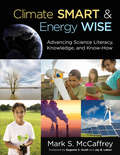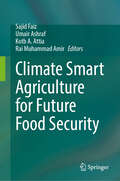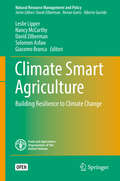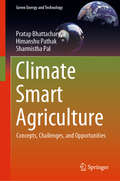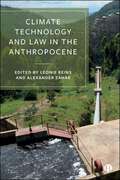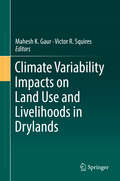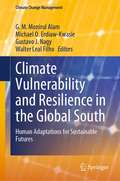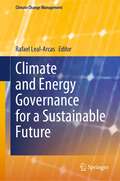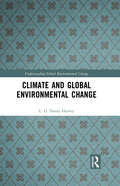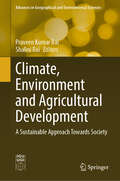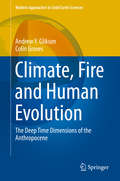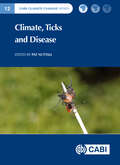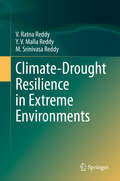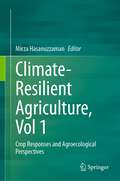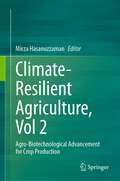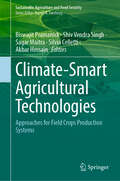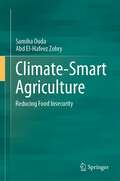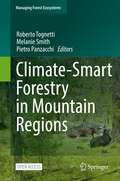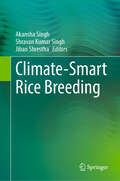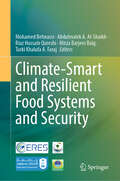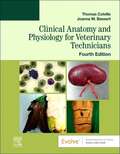- Table View
- List View
Climate Smart & Energy Wise: Advancing Science Literacy, Knowledge, and Know-How
by Mr Mark S. McCaffreyToday’s answers to our most urgent climate issues The twenty-first century ushered in a set of unmistakably urgent global challenges that are too important to be an afterthought in today’s classrooms. Climate Smart & Energy Wise offers a virtual blueprint to climate and energy education, packed with resources and strategies, including: A high-level overview of where climate and energy topics fit (or don't fit) into your current curriculum with connections to the NGSS Proven methods to teach climate change and related topics in a grade-appropriate way Sample learning activities and high-quality online resources
Climate Smart Agriculture for Future Food Security
by Sajid Faiz Umair Ashraf Kotb A. Attia Rai Muhammad AmirThis contributed volume covers recent advancements in the development of climate-resilient agriculturally important crops by focusing on climate change, crop cultivation, crop breeding, and the application of novel biotechnological approaches in line with attaining second Sustainable Development Goal of zero hunger. Climate-smart agriculture is a concept aimed at transforming and reorienting agricultural production systems to ensure food security in the ever-evolving situation of climate change. Widespread alterations in rainfall and temperature patterns have threatened agricultural production and elevated the vulnerability of human dependency on agriculture for food, feed, and fiber. Additionally, global food demand is estimated to increase to feed the estimated global population of 9.7 billion by the year 2050. Climate change, food, and nutritional insecurity pose the greatest challenges for the farming community, researchers, the private sector, civil society, and policymakers to develop more sustainable solutions ensuring food security, plant adaptability, and the mitigation of adverse effects on sustainable food production systems. This book will cover three pillars defined by the Food and Agriculture Organization of the United Nations for climate-smart agriculture: sustainable increase in agricultural production, adaptation, and plant resilience under climate change, and mitigation of environmental degradation through intensive agricultural practices. Furthermore, the book also highlights technological innovations taking place across different disciplines of agriculture to cater to both biotic and abiotic factors in agronomically important crops. This book serves as a useful resource documenting all recent developments made to achieve sustainable crop production. It is an interesting read for master&’s and doctoral-level students, academics, scientists, and researchers in the field of agronomy and agricultural biotechnology.
Climate Smart Agriculture: Building Resilience to Climate Change (Natural Resource Management and Policy #52)
by David Zilberman Leslie Lipper Nancy Mccarthy Solomon Asfaw Giacomo BrancaThis book is open access under a CC BY-NC-SA 3. 0 IGO license. The book uses an economic lens to identify the main features of climate-smart agriculture (CSA), its likely impact, and the challenges associated with its implementation. Drawing upon theory and concepts from agricultural development, institutional, and resource economics, this book expands and formalizes the conceptual foundations of CSA. Focusing on the adaptation/resilience dimension of CSA, the text embraces a mixture of conceptual analyses, including theory, empirical and policy analysis, and case studies, to look at adaptation and resilience through three possible avenues: ex-ante reduction of vulnerability, increasing adaptive capacity, and ex-post risk coping. The book is divided into three sections. The first section provides conceptual framing, giving an overview of the CSA concept and grounding it in core economic principles. The second section is devoted to a set of case studies illustrating the economic basis of CSA in terms of reducing vulnerability, increasing adaptive capacity and ex-post risk coping. The final section addresses policy issues related to climate change. Providing information on this new and important field in an approachable way, this book helps make sense of CSA and fills intellectual and policy gaps by defining the concept and placing it within an economic decision-making framework. This book will be of interest to agricultural, environmental, and natural resource economists, development economists, and scholars of development studies, climate change, and agriculture. It will also appeal to policy-makers, development practitioners, and members of governmental and non-governmental organizations interested in agriculture, food security and climate change.
Climate Smart Agriculture: Concepts, Challenges, and Opportunities (Green Energy and Technology)
by Pratap Bhattacharyya Himanshu Pathak Sharmistha PalThe books deals with the critical issues of climate change and its impact on agriculture and proposes climate smart agriculture as the probable solution to this issue. It discusses the impact of climate change and greenhouse gases emission on agriculture. It covers the strategies and management options of climate smart agriculture by including crop, water, soil, and energy management with examples and case studies. The subject matter has been presented in a very lucid language, containing real-time case studies, questions and few solved problems in specific chapters. The text is further enriched with simple line diagram and figures, chart, flow charts and tables. The book is primarily intended for researchers and professionals in the research areas of environmental science, agriculture, soil science, etc.
Climate Technology and Law in the Anthropocene
by Leonie Reins and Alexander ZaharAvailable open access digitally under CC-BY-NC-ND licence. As climate change accelerates, our window for action is closing. To stay within the "Anthropocene" - an epoch in which humankind as the dominant force shaping the planet retains a degree of control over the destructive processes it has unleashed - global warming must be kept below 2° Celsius. This book explores the unprecedented technological and legal changes required to achieve this. Featuring contributions from leading experts, the essays examine the intersection of technology, law, and environmental values, offering diverse viewpoints on navigating the Anthropocene. Revealing the controversies of rapid technological adoption and legal reform, this is a crucial analysis of a complex future whose many dangers for our society are barely understood.
Climate Variability Impacts on Land Use and Livelihoods in Drylands
by Victor R. Squires Mahesh K. GaurThis edited volume is devoted to the examination of the implications of the inevitable changes wrought by global change on the welfare and livelihoods of tens of millions of people who live in dryland regions. Global change is more than just climate change and the ramifications of changing trade patterns (geopolitical and economic aspects), the shift to the market economy, demographic factors (population growth, urbanization and re-settlement), receive attention here. Land use change specialists, policy makers and natural resource management agencies will find the book very useful.Chapters focus on examples that are drawn from a number of sources including previously unpublished studies on the impact of climate change, markets and economics on pastoralist and dryland farming households. The key focus is to provide readers with insights into the real world implications of change (including an analysis of the drivers of change) on these vulnerable groups within dryland societies. The role of humans as agents of these changes is canvassed. A regional analysis of the world's drylands is also performed including those in Australia, Argentina, India, North America, China, North Africa, Central Asia and Southern Africa.
Climate Vulnerability and Resilience in the Global South: Human Adaptations for Sustainable Futures (Climate Change Management)
by Walter Leal Filho Gustavo J. Nagy G. M. Monirul Alam Michael O. Erdiaw-KwasieThis book provides hands-on conceptual, theoretical, and case study discussions on vulnerability and resilience in the global south. This book covers the core of adaptation strategies in developing countries context in an easy-to-follow theoretical and empirical examples. This book shares contemporary approaches on vulnerability, adaptation strategies, and resilience, which aim to assist its targeted audience (academics, policymakers, and practitioners) to understand and make informed decisions in a wide variety of real-world resilience situations.
Climate and Energy Governance for a Sustainable Future (Climate Change Management)
by Rafael Leal-ArcasThis book includes contributions by leading experts across the globe with the first part of the book focusing on the analysis of the Paris Agreement on Climate Change, examines COP26, and questions the political process in the US for the creation of policy for meaningful greenhouse gas emissions reductions. Part 2 explores various ways in which one can effectively mitigate climate change. The contents provide an analysis of carbon pricing, development of specific green energy technologies to promote economic prosperity, and analysis of electric vehicles and other elements of electrification in areas with carbon-intensive electricity supply. Part 3 analyses the international dimension of energy governance (both regional and global) and climate action. It further provides an analysis of the challenges faced by small island developing states, least-developed countries and other vulnerable places. It also offers an analysis of the prospects for a European Energy Union and explores why energy security and decarbonization are significant. Lastly, it explores global energy governance and how its fragmentation can be reduced. This volume will be a useful reference for those in industry and academia.
Climate and Global Environmental Change (Understanding Global Environmental Change)
by L. D. HarveyClimatic change, now more than ever in this age of global warming, is seen as fundamental to the study of the environment. This text examines the importance of climate as one of the major forcing functions in the global environmental change process. It emphasizes both human-induced climatic change and natural climatic change, providing a comprehensive historical context and important projections for the future. It offers a thorough, up-to-date, critical overview of the physical science behind global warming concerns.
Climate and Global Environmental Change (Understanding Global Environmental Change)
by L. D. HarveyClimatic change, now more than ever in this age of global warming, is seen as fundamental to the study of the environment. This text examines the importance of climate as one of the major forcing functions in the global environmental change process. It emphasizes both human-induced climatic change and natural climatic change, providing a comprehensive historical context and important projections for the future. It offers a thorough, up-to-date, critical overview of the physical science behind global warming concerns.
Climate, Energy and Water
by Karen Hussey Pittock, Jamie and Hussey, Karen and Dovers, Stephen Jamie Pittock Stephen DoversWith the global population expected to reach nine billion by 2050, our capacity to provide enough food, water and energy relies on our understanding and management of the complex interdependencies in the climate-energy-water nexus. This book presents a comprehensive and up-to-date analysis of the interdependencies between these sectors and the knock-on consequences of those interactions for other sectors, such as food production and biodiversity conservation. The interdisciplinary nature of the book across the three sectors of climate, energy and water means that it will be valuable for advanced students, researchers and policymakers across a broad range of fields, including environmental/energy/water/climate policy, environmental economics, climate science, hydrology, ecology and geography.
Climate, Environment and Agricultural Development: A Sustainable Approach Towards Society (Advances in Geographical and Environmental Sciences)
by Praveen Kumar Rai Shalini RaiThis book discusses an emerging context of climate change, environmental degradation, monitoring and management, agricultural vulnerability and its development and adaptation from local to global scale. The book also describes the research methodology in a simple and lucid way so that a researcher can adopt it in his/her field studies. Individual chapters are dedicated to different subjects such as the quantification of climate change impacts on environment; land use land cover; crops in controlled and field conditions; water resources; soil fertility, erosion and carbon sequestration; insects, pests, weeds, microbes and diseases; greenhouse gas emission assessment; regional vulnerability to climate change; and selection of crop. Researchers from around the world and from various fields explore these important topics in the book. The book is a valuable resource for environmentalists, geographers, economists, agronomists, biologists, agricultural scientist, climate modellers, policyanalysts, development agency staff, and graduate and postgraduate students.
Climate, Fire and Human Evolution: The Deep Time Dimensions of the Anthropocene (Modern Approaches in Solid Earth Sciences #10)
by Colin Groves Andrew Y. GliksonThe book outlines principal milestones in the evolution of the atmosphere, oceans and biosphere during the last 4 million years in relation with the evolution from primates to the genus Homo - which uniquely mastered the ignition and transfer of fire. The advent of land plants since about 420 million years ago ensued in flammable carbon-rich biosphere interfaced with an oxygen-rich atmosphere. Born on a flammable Earth surface, under increasingly unstable climates descending from the warmer Pliocene into the deepest ice ages of the Pleistocene, human survival depended on both--biological adaptations and cultural evolution, mastering fire as a necessity. This allowed the genus to increase entropy in nature by orders of magnitude. Gathered around camp fires during long nights for hundreds of thousandth of years, captivated by the flickering life-like dance of the flames, humans developed imagination, insights, cravings, fears, premonitions of death and thereby aspiration for immortality, omniscience, omnipotence and the concept of god. Inherent in pantheism was the reverence of the Earth, its rocks and its living creatures, contrasted by the subsequent rise of monotheistic sky-god creeds which regard Earth as but a corridor to heaven. Once the climate stabilized in the early Holocene, since about ~7000 years-ago production of excess food by Neolithic civilization along the Great River Valleys has allowed human imagination and dreams to express themselves through the construction of monuments to immortality. Further to burning large part of the forests, the discovery of combustion and exhumation of carbon from the Earth's hundreds of millions of years-old fossil biospheres set the stage for an anthropogenic oxidation event, affecting an abrupt shift in state of the atmosphere-ocean-cryosphere system. The consequent ongoing extinction equals the past five great mass extinctions of species--constituting a geological event horizon in the history of planet Earth.
Climate, Ticks and Disease (CABI Climate Change Series #18)
by Charles Hart Peter Cox A. Townsend Peterson Nicholas Johnson Wei Liu Jianhong Wu Richard Wall Domenico Otranto Agustín Estrada-Peña Jeremy Gray Abdul Jabbar Jolyon M. Medlock Sunit Kumar Singh Giovanni Benelli Peter Irwin Richard Bishop Xue Zhang Hao Li DeMar Taylor Deborah Hemming Saeed Alasmari Neil Alexander Abdelghafar Alkishe Reiko Arai Armanda Bastos Gervasio Henrique Bechara John Beier Joshua Benoit Dennis Bente Adrien Blisnick René Bødker Fernando Boinas Sarah Bonnet Nathalie Boulanger Alejandro Cabezas-Cruz Alexandre Rodrigues Caetano Cyril Caminade Jirí Cerny´ Roxanne Albertha Charles Ali Reza Chavshin Rosalind Cornforth Neil Coughlan Lauren Culler Milan Daniel Vlasta Danielova Mona Dehhaghi Maria Diuk-Wasser James P Duffy Olivier Duron Lars Eisen Rebecca Eisen Jana Elsterová Koray Ergünay Li-Qun Fang Natalia Fernández-Ruiz Erol Fikrig Serhii Filatov Durland Fish Janet Foley José De Fuente Roman Ganta Aysen Gargili Keles Robin Beat Gasser Abdul Ghafar Naftaly Githaka Lucy Gilbert Maryna Golovchenko Yuval Gottlieb Ernest Gould Libor Grubhoffer Gilles J. Guillemin Kayleigh M. Hansford John E. Healy Stephen Higgs Andrew Hoodless Yan-Jang S. Huang Bernard Hudson Chris Huntingford Esther Kanduma Sirri Kar Maria Kazimirova Neil Kaye Thomas C. Kelly Lene Jung Kjaer Agatha Onyemowo Kolo Eduard Korenberg Nina Król Chi-Chien Kuo Timothy J. Kurtti Xavier De Lamballerie Patrick A. Leighton L. Robbin Lindsay Geoffrey E. Lynn Ilya Maclean Ben J. Mans Maristela Martins de Camargo Karen D. McCoy Ulrike G. Munderloh Atle Mysterud Sukanya Narasimhan Anna Obiegala Dasiel Obregón Alvarez Dr Nick H. Ogden Mari H. Ogihara Stefan Vilges Oliveira Charlotte Oskam Kennan J. Oyen Neha Pandey Hamed Kazemi Panahi John H. Pettersson Martin Pfeffer L. Paul Phipps Heather J. Plumpton Tatjana Pustahija Ram Raghavan Ryan O.M Rego Annapaola Rizzoli Isobel Ronai Franz Rubel Natalie Rudenko Benjamin Ruiwen Rufus Sage Abdallah M. Samy Gustavo Seron Sanches Isabel Kinney Santos Marcello Otake Sato Megumi Sato Richard Schloeffel Seyyed Javad Seyyed-Zadeh Ladislav Šimo Daniel E. Sonenshine Morgan Sparey Frederic Stachurski Snorre Stuen Matias Pablo Szabó Mike Teglas Sam R. III Saravanan Thangamani Georgia Titcomb Attila J. Trájer Michael Turell Rika Umemiya-Shirafuji Dana L. Vanlandingham Laurence Vial Margarita Villar André B. Wilke G. R. Wint Zbigniew ZajacThis book brings together expert opinions from scientists to consider the evidence for climate change and its impacts on ticks and tick-borne infections. It considers what is meant by 'climate change', how effective climate models are in relation to ecosystems, and provides predictions for changes in climate at global, regional and local scales relevant for ticks and tick-borne infections. It examines changes to tick distribution and the evidence that climate change is responsible. The effect of climate on the physiology and behaviour of ticks is stressed, including potentially critical impacts on the tick microbiome. Given that the notoriety of ticks derives from pathogens they transmit, the book considers whether changes in climate affect vector capacity. Ticks transmit a remarkable range of micro- and macro-parasites many of which are pathogens of humans and domesticated animals. The intimacy between a tick-borne agent and a tick vector means that any impacts of climate on a tick vector will impact tick-borne pathogens. Most obviously, such impacts will be apparent as changes in disease incidence and prevalence. The evidence that climate change is affecting diseases caused by tick-borne pathogens is considered, along with the potential to make robust predictions of future events. This book contains: Expert opinions and predictions. Global coverage of trends in ticks and disease. In-depth examination of climate change and tick distribution links. This book is suitable for researchers and students studying zoology, biological sciences, medical entomology, animal health, veterinary medicine, epidemiology, parasitology, and climate change impacts; and for those concerned with public health planning or livestock management where ticks and tick-borne pathogens pose a threat.
Climate-Drought Resilience in Extreme Environments
by V. Ratna Reddy Y. V. Reddy M. Srinivasa ReddyThis book assesses the effectiveness of changes in watershed interventions in one of the most fragile resource regions of India. Specifically the chapters examine various watershed centred interventions and their implementation process. An evaluation of the livelihood impacts, including crop production on the communities, is discussed and an assessment of the drought and climate resilience of households in the context of watershed and related interventions, including institutions and capacity of the communities, is investigated. Lessons are drawn to further identify measures to strengthen and improvise interventions for enhanced climate-drought resilience in harsh environments.
Climate-Resilient Agriculture, Vol 1: Crop Responses and Agroecological Perspectives
by Mirza HasanuzzamanUnder ongoing climate change, natural and cultivated habitats of major food crops are being continuously disturbed. Such condition accelerates to impose stress effects like abiotic and biotic stressors. Drought, salinity, flood, cold, heat, heavy metals, metalloids, oxidants, irradiation etc. are important abiotic stresses; and diseases and infections caused by plant pathogens viz. fungal agents, bacteria and viruses are major biotic stresses. As a result, these harsh environments affect crop productivity and its biology in multiple complex paradigms. As stresses become the limiting factors for agricultural productivity and exert detrimental role on growth and yield of the crops, scientists and researchers are challenged to maintain global food security for a rising world population.This two-volume work highlights the fast-moving agricultural research on crop improvement through the stress mitigation strategies, with specific focuses on crop biology and their response to climatic instabilities. Together with "Climate Resilient Agriculture, Vol 2: Agro-Biotechnological Advancement for Crop Production", it covers a wide range of topics under environmental challenges, agronomy and agriculture processes, and biotechnological approaches, uniquely suitable for scientists, researchers and students working in the fields of agriculture, plant science, environmental biology and biotechnology.
Climate-Resilient Agriculture, Vol 2: Agro-Biotechnological Advancement for Crop Production
by Mirza HasanuzzamanUnder ongoing climate change, natural and cultivated habitats of major food crops are being continuously disturbed. Such condition accelerates to impose stress effects like abiotic and biotic stressors. Drought, salinity, flood, cold, heat, heavy metals, metalloids, oxidants, irradiation etc. are important abiotic stresses; and diseases and infections caused by plant pathogens viz. fungal agents, bacteria and viruses are major biotic stresses. As a result, these harsh environments affect crop productivity and its biology in multiple complex paradigms. As stresses become the limiting factors for agricultural productivity and exert detrimental role on growth and yield of the crops, scientists and researchers are challenged to maintain global food security for a rising world population.This two-volume work highlights the fast-moving agricultural research on crop improvement through the stress mitigation strategies, with specific focuses on crop biology and their response to climatic instabilities. Together with "Climate Resilient Agriculture, Vol 1: Crop Responses and Agroecological Perspectives", it covers a wide range of topics under environmental challenges, agronomy and agriculture processes, and biotechnological approaches, uniquely suitable for scientists, researchers and students working in the fields of agriculture, plant science, environmental biology and biotechnology.
Climate-Resilient Horticulture: Adaptation And Mitigation Strategies
by Nadipynayakanahally Krishnamurthy Rao Kodthalu Seetharamaiah Shivashankar Harish Chandra SinghClimate change, a global phenomenon, has attracted scientists to contribute in anticipatory research to mitigate adverse impacts, which are more important for horticulture, considering that the scenario is in the midst of revolution, reaching the production level of 250 million tonnes in India. Impacts of climate variability have, invariably, profound influence on production and quality. An understanding of the impacts and relevant adaptation strategies are of foremost importance to sustain the productivity and profitability of horticulture crops in the climate change scenario, which necessitates synthesis of current knowledge to develop strategies for adaptation and mitigation to achieve climate-resilient horticulture. The book Climate-resilient horticulture: adaptation and mitigation strategies addresses the effects of climate change on different horticultural crops and focuses on the adaptation strategies based on the scientific knowledge generated by the experts in different agro-climatic regions in India. Issues have been covered in various chapters to make this book a treasure of knowledge in horticulture vis-a-vis climate change. Some of the crops included in the book are apple, grapes, cashew, banana, litchi, mango, coconut, oil palm, potato, tomato, cucurbits and flowers. In addition to strategies to be adapted in these crops, various other important aspects like carbon sequestration, pests and diseases, and urban landscaping are also covered in the book. Information on climatic risks and adaptation options for resilience in horticultural crops and future strategies and information on pest and disease dynamics on horticultural crops in relation to climate change and available mitigation strategies have also been documented. The book is edited by Dr H P Singh, a visionary leader, and his colleagues, which will be highly valuable to research workers, students, policy planners and farmers to understand and checkmate the adverse effect of climate change, so as to convert weakness into opportunity.
Climate-Smart Agricultural Technologies: Approaches for Field Crops Production Systems (Sustainability Sciences in Asia and Africa)
by Akbar Hossain Biswajit Pramanick Shiv Vendra Singh Sagar Maitra Silvia CellettiThis book addresses the technologies that can be employed to tackle the challenges of global food security. Several recent studies have reported the significant impact of changing climate on the agricultural production, thus posing a challenge in achieving global food security. Thus, to mitigate these challenges there is an urgent need to develop approaches that may be helpful for the sustainability of food production. These approaches are based on three objectives: (i) sustainably increasing agricultural productivity to support equitable increases in farm incomes, food security, and development; (ii) adapting and building the resilience of food systems to climate change; and (iii), where possible, reducing GHGs emissions from agriculture. This book provides updated information for these climate-smart agricultural technologies that hold high potential to increase productivity, improve resilience, and provide efficient resource utilization. This book is a valuable resource for undergraduates, postgraduates, researchers, professors and policymakers in the field of agriculture, botany and agriculture extension functionaries.
Climate-Smart Agriculture: Reducing Food Insecurity
by Samiha Ouda Abd El-Hafeez ZohryThis book tackles the main feature of water-smart, soil-smart and crop-smart practices and their integration to sustainably enhance food production. The book includes some insights on the implications of using climate-smart practices in irrigated and rain-fed agriculture, and suggests approaches to eradicate the negative effects of water scarcity, climate variability and climate change. The book reviews the most important crops resilient to climate variability and their resistance to other biotic and abiotic stresses, and contains the existing practices in Egypt that achieved the three pillars of climate-smart agriculture
Climate-Smart Food
by Dave ReayThis open access book asks just how climate-smart our food really is. It follows an average day's worth of food and drink to see where it comes from, how far it travels, and the carbon price we all pay for it. From our breakfast tea and toast, through breaktime chocolate bar, to take-away supper, Dave Reay explores the weather extremes the world’s farmers are already dealing with, and what new threats climate change will bring. Readers will encounter heat waves and hurricanes, wildfires and deadly toxins, as well as some truly climate-smart solutions. In every case there are responses that could cut emissions while boosting resilience and livelihoods. Ultimately we are all in this together, our decisions on what food we buy and how we consume it send life-changing ripples right through the global web that is our food supply. As we face a future of 10 billion mouths to feed in a rapidly changing climate, it’s time to get to know our farmers and herders, our vintners and fisherfolk, a whole lot better.
Climate-Smart Forestry in Mountain Regions (Managing Forest Ecosystems #40)
by Melanie Smith Roberto Tognetti Pietro PanzacchiThis open access book offers a cross-sectoral reference for both managers and scientists interested in climate-smart forestry, focusing on mountain regions. It provides a comprehensive analysis on forest issues, facilitating the implementation of climate objectives. This book includes structured summaries of each chapter.Funded by the EU’s Horizon 2020 programme, CLIMO has brought together scientists and experts in continental and regional focus assessments through a cross-sectoral approach, facilitating the implementation of climate objectives. CLIMO has provided scientific analysis on issues including criteria and indicators, growth dynamics, management prescriptions, long-term perspectives, monitoring technologies, economic impacts, and governance tools.
Climate-Smart Rice Breeding
by Akansha Singh Shravan Kumar Singh Jiban ShresthaThis book covers all aspects of smart-breeding technologies in creating novel crop architecture to meet future rice demand. Several advanced crop breeding technologies like, marker-assisted backcross breeding, marker-assisted recurrent selection, genomic assisted breeding, haplotype breeding and genome editing technologies have been introduced and employed for rice productivity improvement. Use of artificial intelligence and machine learning in crop phenotype prediction is paving the way for climate-smart breeding. Chapters in this volume cover all these relevant topics. The global rice demand is estimated to rise to 555 and 827.86 million tons in 2035 for milled rice and paddy, respectively. Enhancing high-nutrition rice production under the pressure of global climate change conditions is a hard task for breeders. Changing climatic scenarios and extreme weather conditions have increased the incidence of various biotic and abiotic stresses. Also, every degree rise in global mean temperature causes 3.2 % reduction in rice yield globally. This creates an urgent need for developing high-yielding rice varieties to tackle the aggravated issue of food security. This book is meant for scientists, professionals, researchers, and students working on enhancing rice production through advanced plant-breeding technologies.
Climate-Smart and Resilient Food Systems and Security
by Mohamed Behnassi Mirza Barjees Baig Abdulmalek A. Al-Shaikh Riaz Hussain Qureshi Turki Khalufa A. FarajThis contributed book, as a part of a series of CERES publications, contributes to the scientific debate about the interlinkages between climate change, environment, and food systems. It highlights the opportunities to accelerate the transformation of such systems within the perspective of sustainable, inclusive, and climate-smart practices. Most chapters are based on empirical research particularly done in vulnerable and resource-constrained countries from the Global South (such as India, Kenya, Pakistan, South Asia, Sri Lanka, and Vietnam) and provide policy-oriented inputs and recommendations to guide change processes at multiple scales. This project has implications for research, innovation, and policy design.
Clinical Anatomy and Physiology for Veterinary Technicians
by Joanna M. Bassert Thomas P. ColvilleStart your veterinary technician education off on the right foot with Clinical Anatomy and Physiology for Veterinary Technicians, 4th Edition. Combining expert clinical coverage with engaging writing and vivid illustrations, this popular text is the key to understanding the anatomic and physiologic principles that will carry you throughout your career. In addition to its comprehensive coverage of the diverse ways in which animal bodies function at both the systemic and cellular levels, this textbook features a variety of helpful application boxes, vocabulary lists, and Test Yourself questions in every chapter to ensure you have a firm grasp of anatomic structure and its relevance to clinical practice.
